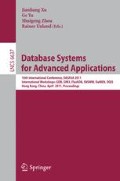Abstract
Data Type Definition(DTD) and XML Schema Definition(XSD) are the logical schema of an XML model, but there is no standard format for the conceptual schema of an XML model. Conceptual modeling is a very important first step for constructing a database application. A conceptual model describes a system that is being built. Abstract ideas are made concrete as the ideas are represented in a formal notation. A formal conceptual model has a number of advantages. First, it helps designers understand and document the application under construction. Second, it facilitates development of algorithms that derive the underlying database schemas. In this paper, a real world of interest is described in a conceptual-model Hypergraph, which is a generic conceptual model. It is a Hypergraph because its hyperedges, or simply edges, are not necessarily binary. Its vertices represent sets of objects and its edges represent relationships among the vertices. Edges in a Hypergraph can be directed or undirected, depending on whether the underlying relationships are functional or non-functional. As opposed to relational databases, in this paper we are interested in constructing XML database applications with “good” properties. Two properties are particularly outstanding. First, the database should not have redundant data because redundant data lead to multiple-update problem once a single copy is modified. Second, since joins are expensive, the number of generated scheme trees, which are a generic hierarchical storage structure, should be as few as possible in order to reduce the number of joins required to answer a query. Users can draw a Hypergraph as XML conceptual schema with data relationships among elements as a result of specified functional dependency and multivalued dependency.
Access this chapter
Tax calculation will be finalised at checkout
Purchases are for personal use only
Preview
Unable to display preview. Download preview PDF.
References
Mok, W.Y., Embley, D.W.: Generating compact redundancy-free XML documents from conceptual-model Hypergraphs. IEEE Transactions on Knowledge and Data Engineering 18(8), 1082–1096 (2006)
Bourret, R.: XML database products (March 2007), http://www.rpbourret.com/xml/XMLDatabaseProds.htm
Sagiv, Y.: A characterization of globally consistent databases and their correct access paths. ACM Transactions on Database Systems 8(2), 266–286 (1983)
Maier, D.: The Theory of Relational Databases. Computer Science Press, Rockville (1983)
Codd, E.F.: Recent investigations in relational data base systems. In: IFIP Congress, pp. 1017–1021 (1974)
Mok, W.Y., Fong, J., Embley, D.W.: Extracting a largest redundancy-free xml storage structure from an acyclic Hypergraph in polynomial time. Information Systems 35(7), 804–824 (2010)
Chen, Y., Davidson, S.B., Hara, C.S., Zheng, Y.: RRXF: Redundancy reducing XML storage in relations. In: Proceedings of 29th International Conference on Very Large Data Bases, Berlin, Germany, September 9-12, pp. 189–200 (2003)
Libkin, L.: Normalization theory for XML. In: Proceedings of the 5th International XML Database Symposium, Vienna, Austria, September 23-24, pp. 1–13 (2007)
Schewe, K.-D.: Redundancy, dependencies and normal forms for XML databases. In: Proceedings of the Sixteenth Australasian Database Conference, Newcastle, Australia, January 31-February 3, pp. 7–16 (2005)
Vincent, M.W., Liu, J., Liu, C.: Strong functional dependencies and their application to normal forms in XML. ACM Transactions on Database Systems 29(3), 445–462 (2004)
Wang, J., Topor, R.W.: Removing XML data redundancies using functional and equality-generating dependencies. In: Proceedings of the Sixteenth Australasian Database Conference, Newcastle, Australia, January 31-February 3, pp. 65–74 (2005)
Yu, C., Jagadish, H.V.: XML schema refinement through redundancy detection and normalization. The VLDB Journal 17(2), 203–223 (2008)
Mok, W.Y., Ng, Y.-K., Embley, D.W.: A normal form for precisely characterizing redundancy in nested relations. ACM Transactions on Database Systems 21(1), 77–106 (1996)
Lu, S., et al.: On the Consistency of XML DTDs. Data of Knowledge Engineering 52, 231–247 (2005)
Xiao, J., et al.: FIXT: A Flexible Index for XML Transformation. In: Zhou, X., Zhang, Y., Orlowska, M.E. (eds.) APWeb 2003. LNCS, vol. 2642, pp. 144–149. Springer, Heidelberg (2003)
Funderburk, J.E., et al.: XTABLES: Bridging Relational Technology and XML. IBM Systems Journal 41(4), 616–641 (2002)
Fong, J., Cheung, S.K., Shiu, H.: The XML Tree Model - Toward an XML Conceptual Schema Reversed from XML Schema Definition. Data and Knowledge Engineering 64(3), 624–661 (2008)
Salim, F.D., Price, R., Indrawan, M., Krishnaswamy, S.: Graphical representation of XML schema. In: Yu, J.X., Lin, X., Lu, H., Zhang, Y. (eds.) APWeb 2004. LNCS, vol. 3007, pp. 234–245. Springer, Heidelberg (2004)
Salim, F.D., Price, R., Krishnaswamy, S., Indrawan, M.: UML Documentation Support for XML Schema. In: Proceedings of the 2004 Australian Software Engineering Conference, p. 211. IEEE Computer Society, Los Alamitos (2004)
Author information
Authors and Affiliations
Editor information
Editors and Affiliations
Rights and permissions
Copyright information
© 2011 Springer-Verlag Berlin Heidelberg
About this paper
Cite this paper
Fong, J., Mok, W.Y., Li, H. (2011). Design Non-recursive and Redundant-Free XML Conceptual Schema with Hypergraph (Extended Abstract). In: Xu, J., Yu, G., Zhou, S., Unland, R. (eds) Database Systems for Adanced Applications. DASFAA 2011. Lecture Notes in Computer Science, vol 6637. Springer, Berlin, Heidelberg. https://doi.org/10.1007/978-3-642-20244-5_5
Download citation
DOI: https://doi.org/10.1007/978-3-642-20244-5_5
Publisher Name: Springer, Berlin, Heidelberg
Print ISBN: 978-3-642-20243-8
Online ISBN: 978-3-642-20244-5
eBook Packages: Computer ScienceComputer Science (R0)

